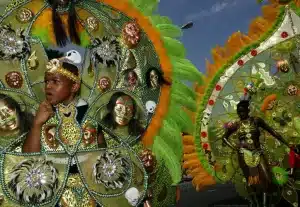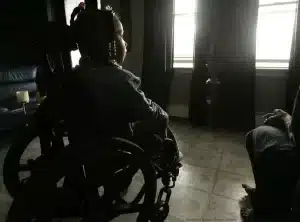First of all, let’s be clear about this. There are many different types of portraits. In this post, I am only going to refer to two kinds: Controlled- Setting portraits and Candid or “Found” Portraits. However, these categories could be subdivided into many other categories. So for the sake of simplicity, in this blog, I am only going to focus on these two types.
Controlled portraits: This is where you get to pick the setting, i.e. studio, or a specific place. For these, is very likely you’ll also have full control of the type of light you’ll be using. These, at times, turn into full productions with many moving parts i.e. location, lighting, photographic gear, etc.

These examples of Controlled Portraits all have varying degrees of lighting complexity. The first one was shot in a studio and it was a portrait of three Boston exotic dancers for a story on the Magic Mike movie. The second one is a quinceañera photo shoot on location outdoors at Vizcaya in Miami, Fla. The third one is an impromptu set up on location, at a DC hotel, of actor Nicholas Christopher with Hamilton.
Seven Tips to create Impactful Controlled/ Set- up Portraits
- Have a plan, a concept, or an idea, and figure out how to execute it.
2. Make sure to bring with you all the equipment you are going to need in order to pull it off. We are talking about artificial lights, props, light modifiers, V-flats, stands, power cords, surge protectors, etc. A good example of all it takes to set up an on-location shoot is his time-lapse of a job I recently did in San Juan Puerto Rico.
3. Be flexible. If it’s an on-location shoot, once you arrive on-site pay close attention to what the natural light is doing. For example, if Mother Nature is giving you a fantastic shaft of light against a great background other than the one you had in mind, then disregard your plans and use the natural light setup. Keep an open mind and allow yourself to take advantage of the God-given opportunities even if it means changing your initial concept.

Actress Elizabeth Banks photographed in Boston at the Liberty Hotel for the Boston Globe. This was a classic example where I brought lights and I had a shooting formula/ plan in mind. But once I arrived at the venue and saw the shafts of natural light filling the inner courtyard. I decided to go with ambient light.
4. If you are using an assistant, especially one with experience, don’t disregard their comments and opinions. They might point out things you are likely to miss because you have developed “tunnel vision.” In other words, you are so focused on your subject that you miss details. For example, your assistant might notice a minute stain on your subject’s blouse or shirt. Or perhaps they might notice a missing button, a wayward strand of hair, a brand tag sticking out of a collar, etc.
5. If you have an agreeable subject that allows you to shoot until you think you have what you want, then, by all means, do take advantage of their generosity but do not abuse of their time.

A very-busy IPG Photonics CEO Valentin Gapontsev, only had a couple of minutes for this portrait. So, I arranged to have one of his techs demonstrate how to use one of Photonics’ 20,000- watt fiber lasers. Setting this up with the tech, and doing test shots with the PR as a stand it took me about 45 minutes. However, it was only when I had everything ready to go that I brought the CEO to stand where I wanted to photograph to happen. In the end, he only had to pose for me for 10 minutes and this pleased him very much for I had respected his busy schedule.
6.The end result of controlled portraits sometimes relies heavily on post-production. So, keep that in mind. This process might include adding other elements to the photo after you are done shooting, ergo altering reality. At this point, we are now talking about not Portraits but Photo illustrations, which is another topic altogether. However, what you need to keep in mind is whether or not you need to leave some space around your subject in order to be able to add other elements in post-production. Also, direct your subject’s positioning within the frame and perhaps even their posture as to make sure all parts will fit once post production is put into play.
7. Keep it light, keep it fun, be communicative with your subjects and maintain them informed of how well they are doing, tell them exactly what you are doing and why. There’s nothing worst that finding yourself in an unusual situation, i.e. a portrait session, and not knowing what’s going on or how long will it take to be done. Smile and chat!
On Impromptu/ candid portraits:
These types of portraits, which I like to call “found portraits,” require that you go with the flow and try to maximize whatever light is available. Usually, you most likely won’t have the ability to control the setting, other than where you and your camera are in reference to your subject. A good example of this type of portraits would be the ones you make while doing Street Photography.

The subjects on these “found portraits” are exactly how I encountered them.
The first one on the left is a woman showing the art of using a fan for seduction. The middle one is an Ukrainian woman protesting at the Lincoln Memorial against the Russian attack on her country. The third one was a man having a conversation with someone at the entrance of a hotel in Old Havana.
These types of portraits are ubiquitous. However, you need to slow down and to closely watch in order to recognize these portrait opportunities. In other words, you need to heed the mantra that I live by when it comes to photography: Be alert, be aware, anticipate, and act fast for these gems tend to be ephemeral.
Seven Tips for Found or Impromptu Portraits

Seven-year old Joel Niles of Boston takes part in the Caribbean Festival in Dorchester, MA.
- When you come across interesting characters think interesting portraits. Once you identify your subject, slow down and start looking at their immediate surroundings and their background and how this is going to affect the final photo.
2. Realize on this one, you are just coming along for the ride. You don’t have any control over what they do, where they are, or their emotions. So, you must shoot as the proverbial adage says, “fast and furious” without interrupting their actions.
3. Pay close attention to how the light hits your subjects regardless of whether this is natural or artificial light.

Roxbury, Ma– Kai Leigh Harriott , 5, who was accidentally shot by a Boston gangbanger faced him in court and forgave him.
4. Be hyper-mindful of their background. Remember, you might not be able to control the situation but 99% of the time you will have control of tiny adjustments that you can make to your positioning. This will allow you clean the backgrounds in order to get the best possible outcome.
5. Once you’ve identified your subject, shoot fast and furious for once you’ve been found the gig is up! At that point, smile at them, and if they are agreeable then perhaps you continue shooting. And, who knows, they might even allow you turn the situation into a “controlled portrait” where they’d be willing to take your directions while you do your portrait.
6. See it, move fast, frame it and grab it!
7. If they spot you and they don’t react favorably to being photographed don’t push the issue. Don’t argue with them. Instead gracefully raised one hand palm out at chest level and then as you nod to them bring that same palm to your chest, now palm in. This is a universally understood and accepted gesture of respect, gratefulness, and understanding.
The most important thing to remember about Portrait Photography, be it in an impromptu or a controlled scenario, it is all about capturing a bit of the essence of your subjects in a way that is visually appealing to your audience.
If you can do this in a compelling manner, and in such a way you make the reader stop scrolling and spend just a bit longer with your photo, then it is very probably you made a great portrait.




